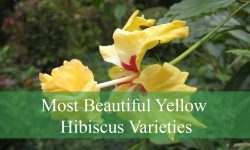Wildflowers in California are among the most stunning natural displays in the United States. Every spring, fields, hillsides, and deserts come alive with vibrant colors as a wide variety of beautiful blooms appear. From the iconic California Poppy to delicate Baby Blue Eyes, these wildflowers create unforgettable scenes across the state.
California’s wildflower diversity is truly remarkable, with species perfectly adapted to different climates and landscapes. Exploring coastal meadows, mountain foothills, or desert plains reveals unique and colorful wildflowers in nearly every region. This variety makes California a top destination for nature lovers and photographers eager to see spectacular floral displays.
This article introduces the 20 most popular and beautiful wildflowers in California. Each species showcases the rich botanical heritage of the state and offers insight into where and when to find these gorgeous plants in bloom. Get ready to discover the natural beauty of wildflowers in California!
Common Stunning Wildflowers Found in California
California Poppy (Eschscholzia californica)
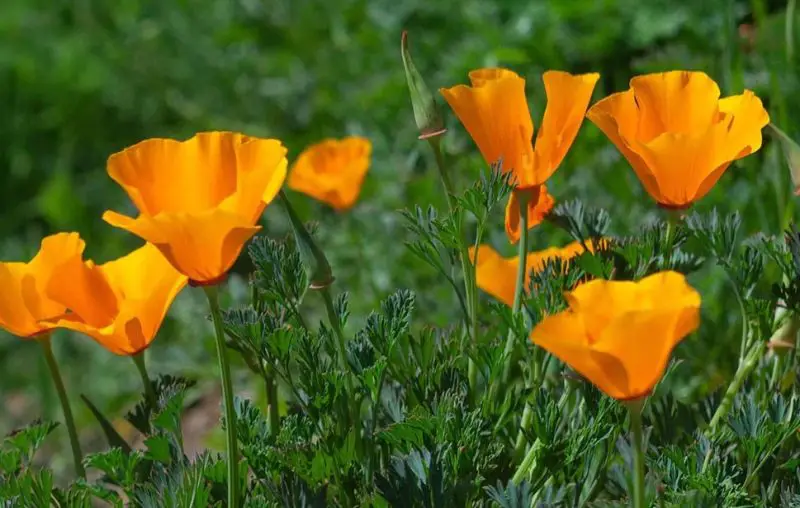
The California Poppy is the official state flower of California and stands out for its glowing orange to golden-yellow petals. These cup-shaped blooms open with sunlight and close at night or during cool, cloudy weather. The plant typically reaches heights between 12 and 18 inches, with finely cut, bluish-green foliage that gives it a soft, fern-like appearance. Its flowers appear in great abundance from early spring through late May, especially in years with good winter rainfall.
This poppy thrives in full sun and well-drained soils, favoring the dry slopes, grassy fields, and desert margins found throughout California. You’ll often find it blooming along highways, in wildflower preserves, and in rolling hillsides. The Antelope Valley California Poppy Reserve is one of the most famous locations to see breathtaking displays, especially during “super bloom” seasons.
Beyond its vivid beauty, the California Poppy is drought-tolerant and self-seeding, making it a favorite among native plant gardeners. Though orange is the most common color, cultivars and wild variations also produce flowers in pale yellow, cream, and even reddish hues. Its long-lasting flowers, ease of growth, and symbolic value make it one of the most celebrated wildflowers in the state.
Lupine (Lupinus spp.)
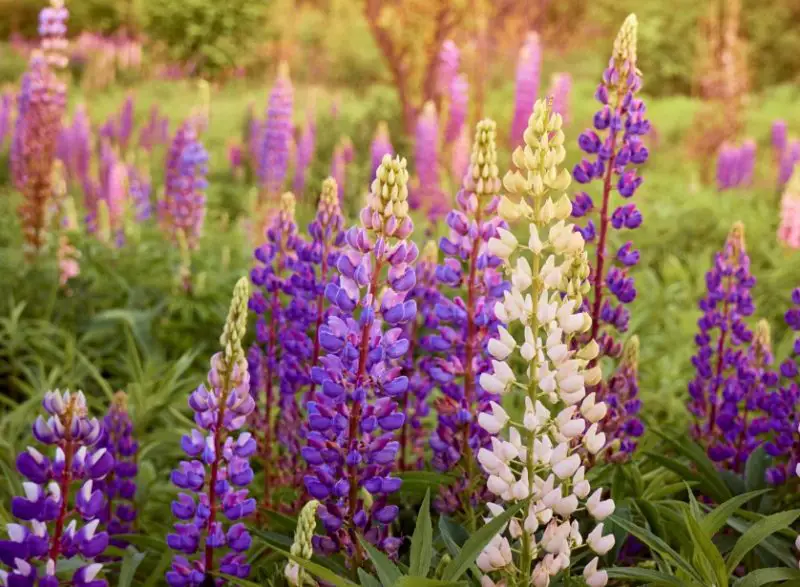
Lupines are one of California’s most widespread and showy wildflower groups, featuring tall, elegant spikes of pea-like flowers in shades of purple, blue, pink, white, and occasionally yellow. These upright plants often grow between 1 and 3 feet tall, depending on the species, and are easily recognized by their whorled, palmate leaves which resemble open hands. The dense flower clusters bloom in vertical columns, making them highly attractive to both humans and pollinators.
Lupines can be seen from early spring through summer, blooming first in lower elevations and then later in alpine meadows. They flourish across a wide variety of habitats, including coastal bluffs, chaparral hillsides, mountain trails, and inland valleys. Notable wildflower sites where lupines thrive include Big Sur, Lake Tahoe, and the Carrizo Plain.
Ecologically, lupines play a valuable role as nitrogen fixers, enriching the soil and supporting nearby plant life. They also serve as food plants for certain butterfly larvae, including endangered species like the Mission Blue. With their adaptability, striking appearance, and ecological significance, lupines are among California’s most admired and important wildflowers.
Tidy Tips (Layia platyglossa)
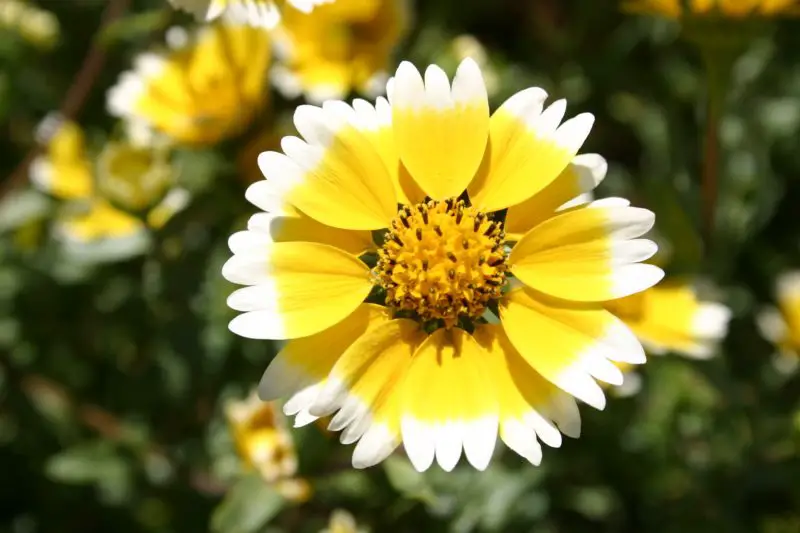
Tidy Tips is a cheerful and easily recognizable wildflower native to California, distinguished by its bright yellow petals trimmed with crisp white edges. Each daisy-like bloom measures 1 to 2 inches across and grows atop slender green stems reaching 6 to 18 inches in height. The plant’s foliage is light green and slightly sticky, and its neat, symmetrical flowers give it a “tidy” and pleasing look that inspired its common name.
This annual wildflower blooms from March through May and is typically found in open, sunny habitats such as coastal valleys, lowland fields, and grassy foothills. It thrives in sandy or loamy soil with good drainage and is especially abundant during years with regular spring rainfall. Tidy Tips often grows alongside other colorful wildflowers like California Poppies and Goldfields, creating vivid springtime scenes in places like Central Valley and the Carrizo Plain.
Tidy Tips are loved by native plant gardeners and wildflower enthusiasts alike for their striking two-toned appearance and ease of cultivation. They attract a wide range of pollinators, including bees and butterflies, and readily reseed themselves in favorable conditions. Their bold colors, neat form, and ecological benefits make them a charming addition to California’s diverse wildflower palette.
Baby Blue Eyes (Nemophila menziesii)
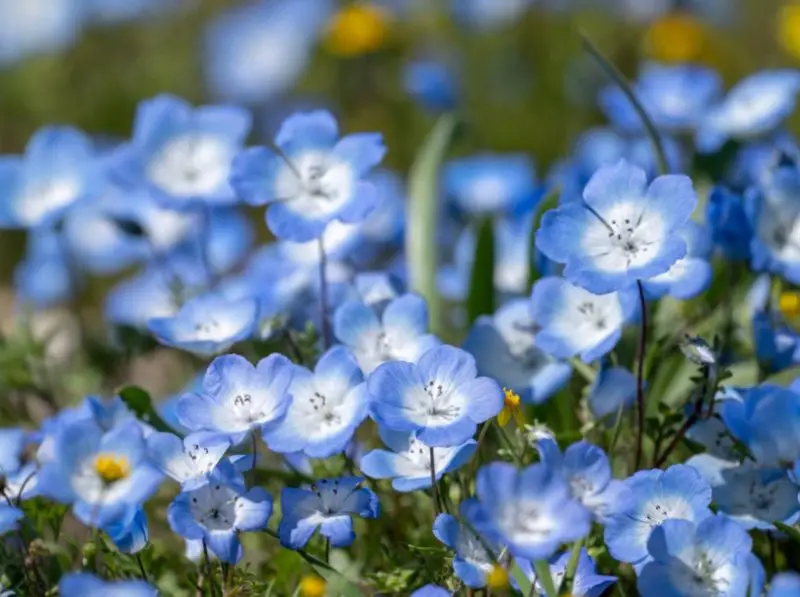
Baby Blue Eyes is a delicate and charming wildflower that adds a soft touch to California’s spring landscapes. The flowers are pale to vivid sky-blue with a white center and gently rounded petals. Each bloom measures around one inch wide and sits above soft, green, deeply lobed foliage. The plant itself is low-growing and spreads outward, forming a ground-hugging mat that covers the soil like a floral carpet.
This species blooms from February through May, preferring cool, partly shaded environments with well-drained but moist soils. It naturally grows in a variety of habitats, including open woodlands, grassy hills, and coastal meadows. It is especially prevalent along the Central Coast, in the Sierra Nevada foothills, and northern parts of the state where spring rainfall is dependable.
Often included in native seed mixes, Baby Blue Eyes is highly valued in wildflower gardens for its early blooming, gentle aesthetic, and attractiveness to pollinators. It is easy to grow in partial shade and blends beautifully with other native species. Its pastel blue hues and low, spreading form make it a peaceful yet eye-catching component of California’s wildflower displays.
Indian Paintbrush (Castilleja spp.)
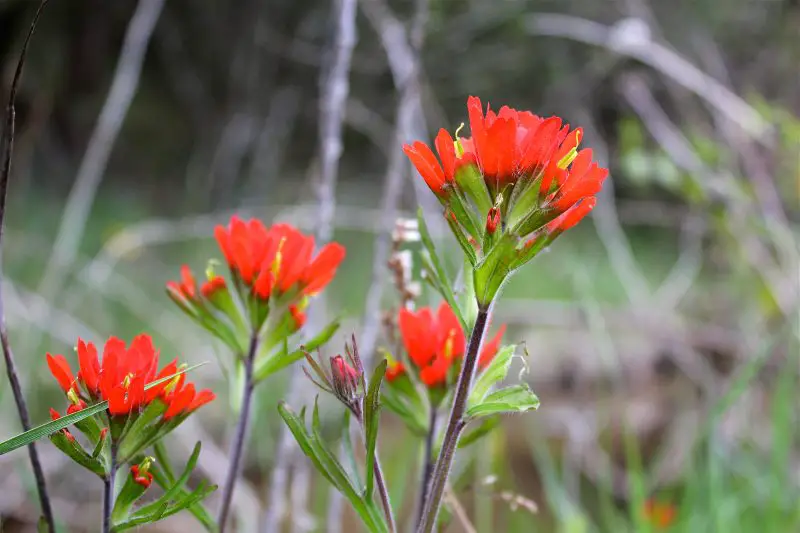
Indian Paintbrush is a striking and unusual wildflower easily identified by its vivid red, orange, or pink bracts that resemble a paint-dipped brush. The true flowers are small and tubular, hidden within these colorful bracts, and are often greenish or yellow. Depending on the species and conditions, Indian Paintbrush can grow anywhere from 6 inches to over 2 feet tall. The stems are upright, with narrow, toothed leaves spaced along their length.
This wildflower blooms from March to July and appears in many types of terrain across California. It is especially common in mountain meadows, open pine forests, grasslands, and even coastal scrublands. You’ll often spot Indian Paintbrush growing alongside other native species like Lupine and Owl’s Clover, particularly in places such as Yosemite, Sequoia National Park, and the Sierra Nevada foothills.
What makes Indian Paintbrush unique is its semi-parasitic nature—it draws some nutrients from the roots of nearby host plants, such as grasses and shrubs. This relationship makes it challenging to grow in gardens, but in the wild, it contributes to its hardiness and survival. Indian Paintbrush also attracts hummingbirds and native bees, making it not only beautiful but ecologically important in California’s wild ecosystems.
Desert Marigold (Baileya multiradiata)
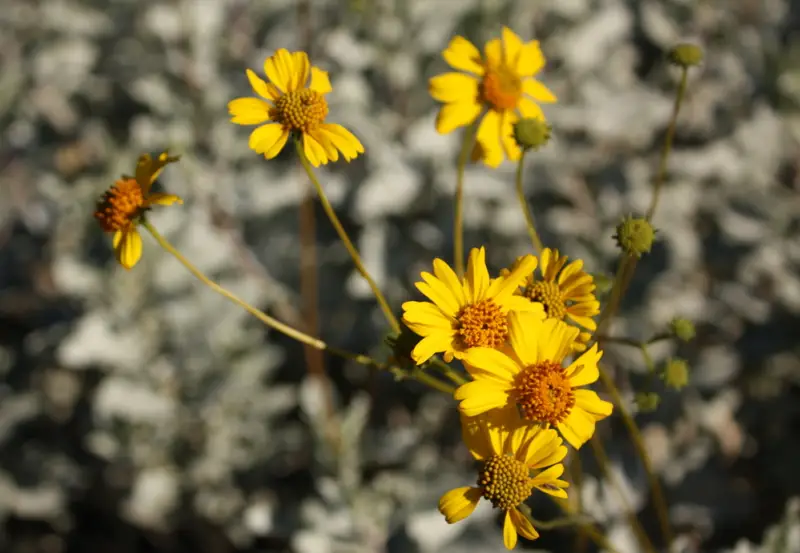
Desert Marigold is a bright, sun-loving wildflower that thrives in California’s arid southern landscapes. Its daisy-like flowers are a brilliant golden yellow, typically measuring 1 to 2 inches in diameter. The blooms grow on slender, leafless stems that can reach up to 2 feet tall, rising from a base of silvery-gray, woolly leaves. The entire plant has a fuzzy appearance due to the fine hairs that help reflect sunlight and conserve moisture—an important adaptation for desert life.
This species blooms from early spring through fall, with peak displays often seen in March through May, especially following rainy winters. It is commonly found in the Mojave and Sonoran Deserts, often along roadsides, dry washes, rocky slopes, and open desert plains. Desert Marigold thrives in full sun and well-drained, sandy soils, where it can form impressive displays when conditions are right.
Though it looks delicate, Baileya multiradiata is a tough survivor. It reseeds freely and can withstand high temperatures and extended dry periods. Its bright yellow flowers attract native bees, butterflies, and other pollinators, while its drought resistance makes it a valuable species for native restoration and xeriscape gardens. The plant’s long blooming season and bold color bring warmth and vitality to California’s desert bloomscape.
Farewell-To-Spring (Clarkia amoena)

Farewell-To-Spring is a charming and showy wildflower that lives up to its name by blooming at the end of the spring season. Its flowers are cup-shaped and come in striking shades of pink, rose, lavender, and magenta, often with deeper-colored markings near the center. Each bloom has four broad petals, giving it a delicate, symmetrical form. The plant typically grows 1 to 2.5 feet tall and features slender green stems with narrow, lance-shaped leaves.
This species usually blooms from May to July, later than many other wildflowers, making it a colorful standout when early bloomers begin to fade. It is native to western and central California, especially in coastal grasslands, open woodlands, and disturbed areas. It thrives in well-drained soil and full sun, though it can tolerate partial shade in cooler regions. Farewell-To-Spring is commonly seen in the Bay Area, Central Coast, and Sierra foothills.
Clarkia amoena is often used in wildflower gardens and seed mixes because of its vibrant color, ease of growth, and prolonged blooming season. It supports bees, butterflies, and other pollinators, making it both an ornamental and ecological asset. As one of the last wildflowers to bloom each year, Farewell-To-Spring adds a final splash of color to California’s meadows and natural spaces before the summer dry season takes hold.
Owl’s Clover (Castilleja exserta)
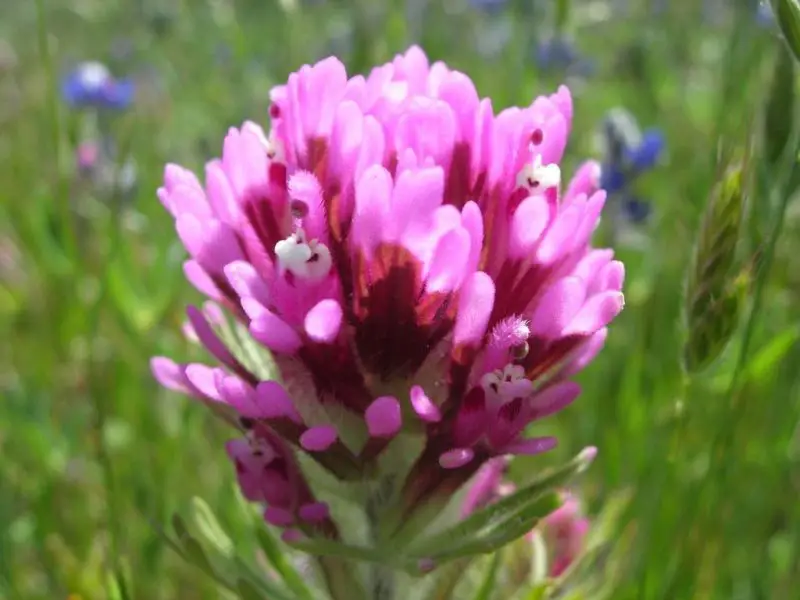
Owl’s Clover is a beautiful and somewhat whimsical wildflower known for its densely packed, brush-like flower heads in shades of lavender, pink, or magenta. Although similar in appearance to Indian Paintbrush, Owl’s Clover has a softer, more feathery look. The flower spikes emerge above green or reddish stems that reach 6 to 20 inches tall, with finely divided, thread-like leaves that blend into grassy habitats.
Blooming from March through May, Owl’s Clover thrives in open fields, coastal plains, and grassy hillsides throughout central and southern California. It often appears in the same wildflower-rich landscapes as California Poppies and Lupines, contributing to the multicolored spring carpets seen in places like the Carrizo Plain and Temblor Range. This species prefers full sun and well-drained soils, particularly after winter rains.
Castilleja exserta is partially parasitic, relying on nearby host plants to supplement its nutrients, which allows it to grow successfully in nutrient-poor soils. This ecological strategy helps it compete in the wild and thrive in native plant communities. Owl’s Clover is especially attractive to bees and butterflies, making it both visually stunning and ecologically significant in California’s spring wildflower season.
Blue-Eyed Grass (Sisyrinchium bellum)

Blue-Eyed Grass is a small, grass-like wildflower that adds subtle beauty to California’s meadows and woodlands. Despite its name, it’s not a true grass but a member of the iris family. Its flowers are star-shaped and violet-blue to purplish in color, each with six petals and a bright yellow center. The plant grows in clumps with slender, upright green leaves that resemble blades of grass, reaching 6 to 18 inches in height.
This species blooms from February through June, often in response to winter and early spring rains. It is commonly found in moist meadows, oak woodlands, coastal bluffs, and open forest edges, especially in central and northern California. It prefers partial sun and well-drained soil, though it can tolerate drier conditions once established. You’ll often see it growing in drifts along trails and under light tree cover.
Sisyrinchium bellum is a favorite among native plant gardeners because of its graceful form, compact growth habit, and compatibility with other spring bloomers. It supports early-season pollinators like native bees and small butterflies. While delicate in appearance, it is surprisingly hardy and can thrive in a variety of soil conditions. Its subtle blooms and fine-textured foliage bring elegance to both wild and cultivated spaces.
Desert Lily (Hesperocallis undulata)
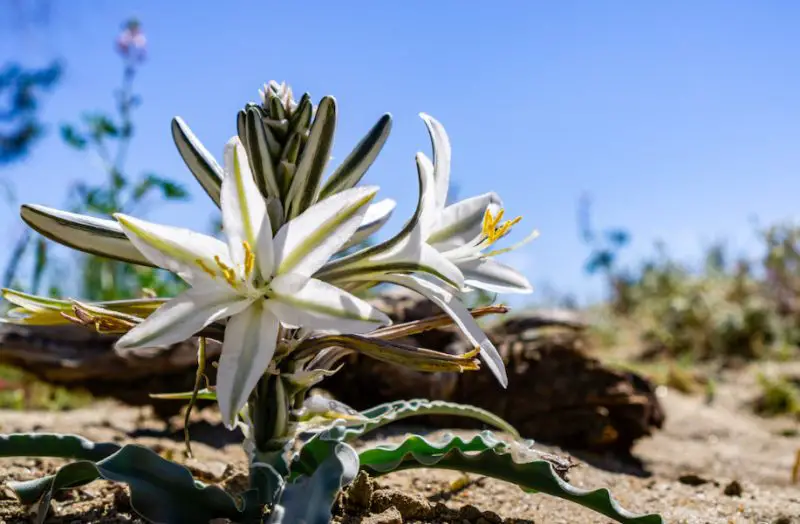
Desert Lily is one of the most elegant and rare wildflowers found in California’s desert regions. Its trumpet-shaped, creamy white flowers resemble those of an Easter lily, with six delicate, slightly curled petals and a soft fragrance. Each flowering stalk can grow up to 3 feet tall and bears multiple blooms, rising from a basal rosette of wavy, blue-green leaves that grow close to the ground. The plant emerges from a deep underground bulb, allowing it to wait patiently for ideal blooming conditions.
This stunning wildflower typically blooms from February through April, depending on rainfall. It is native to the sandy soils of the Mojave and Colorado Deserts, particularly in areas like Anza-Borrego Desert State Park and Joshua Tree National Park. Desert Lilies are often seen in wide-open flats or along desert washes, blooming spectacularly after winter rains.
Because it relies on sufficient moisture and undisturbed soil, Hesperocallis undulata is a rare sight in drought years or heavily trafficked areas. However, when conditions align, its graceful flowers create a striking contrast against the barren desert landscape. The Desert Lily is pollinated by night-flying insects like moths, and its deep bulb stores energy to sustain the plant through long dry periods. It is a symbol of resilience and fleeting desert beauty.
Fiddleneck (Amsinckia spp.)
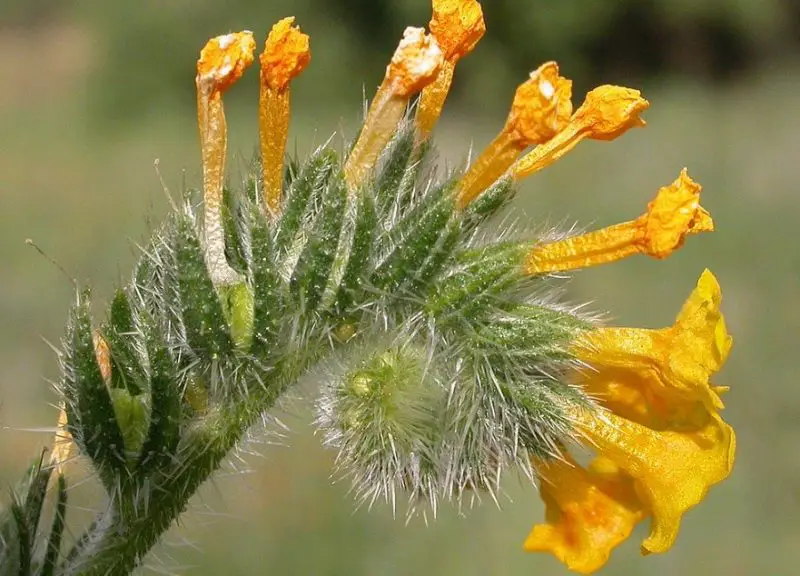
Fiddleneck is a distinctive wildflower named for the coiled shape of its flower cluster, which resembles the curved neck of a violin. Its tiny, bright orange to yellow, trumpet-shaped blooms grow along one side of a spiraling stem. The plant is typically covered in coarse, bristly hairs and can reach heights of 1 to 3 feet. Its leaves are narrow, hairy, and alternate along the stem, giving it a rugged, weedy look when not in bloom.
This wildflower blooms from February through June and is commonly found in open fields, roadsides, pastures, and disturbed soils throughout California. It thrives in full sun and a wide range of soil types, from clay to sand, and can quickly colonize areas following winter rains. Fiddlenecks are often seen in massive numbers, sometimes carpeting hillsides and valleys with brilliant golden color in early spring.
Although beautiful, Amsinckia species are sometimes avoided by grazing animals due to the presence of toxic alkaloids. However, they provide nectar to a variety of insects, especially bees, butterflies, and hoverflies. Their early blooming habit helps support pollinator activity during cooler months. Despite their rough texture, fiddlenecks are an important part of California’s native springtime flora and contribute greatly to its golden spring landscapes.
Goldfields (Lasthenia spp.)
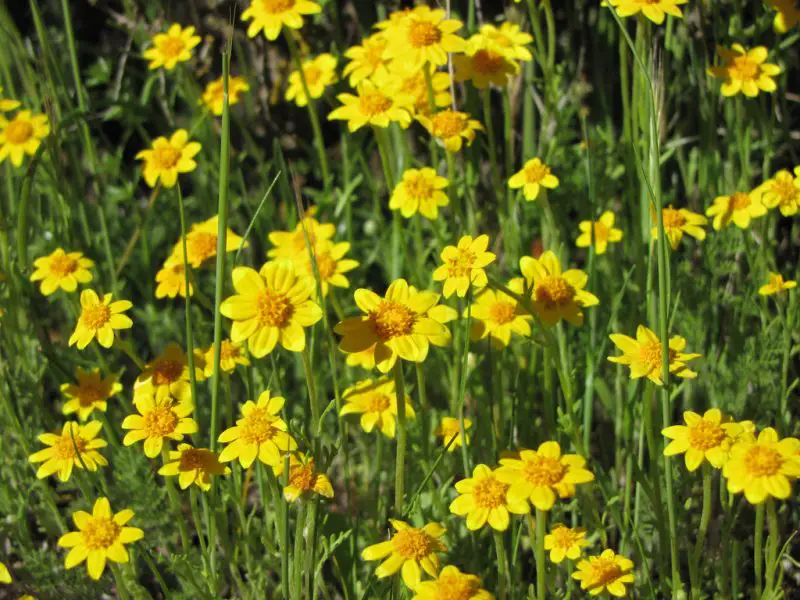
Goldfields are cheerful, small wildflowers that blanket California fields in bright yellow during the peak of spring. These daisy-like flowers have yellow petals with golden centers and are typically no more than a few inches wide. The plants themselves are low-growing annuals that form dense mats or low mounds, often creating the appearance of a golden carpet when blooming in large numbers.
These wildflowers usually bloom from March through May and thrive in grasslands, vernal pools, valley floors, and along roadsides. They are common throughout the Central Valley, coastal plains, and foothill regions of California. Goldfields prefer sunny locations with well-drained soils and benefit from winter and early spring rainfall, often appearing alongside other native species such as tidy tips and California poppies.
Lasthenia species are beloved for their visual impact and ecological benefits. They are a food source for native pollinators, including bees and beetles. Their ability to thrive in tough conditions and quickly establish themselves makes them valuable in wildflower restoration and native landscaping. Goldfields are one of the most visually iconic signs of spring in California and represent the state’s seasonal transformation from brown to brilliant yellow.
Cream Cups (Platystemon californicus)
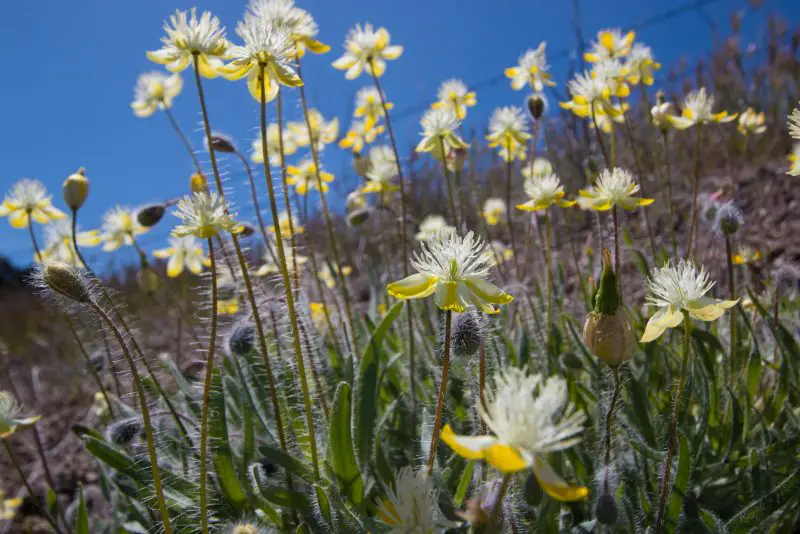
Cream Cups are delicate and graceful wildflowers native to California, known for their soft, creamy-white or pale yellow petals. The flowers are cup-shaped with a silky texture and typically measure about one inch in diameter. Each plant remains relatively small, usually 6 to 12 inches tall, with narrow green leaves and slender stems that support the solitary blooms.
This species blooms from March through May and is found in dry grasslands, open hills, and sandy soils across central and southern California. It prefers full sun and well-drained soils and is often seen alongside poppies, goldfields, and owl’s clover during peak bloom seasons. Its understated appearance offers a visual contrast to the brighter wildflowers, adding diversity and softness to spring displays.
Platystemon californicus is appreciated by native plant enthusiasts for its subtle beauty and contribution to spring pollination. It attracts bees and other small insects, offering nectar in early spring when resources are scarce. Though often overlooked due to its pale color, Cream Cups hold their own as part of California’s vibrant wildflower ecosystems and are a symbol of quiet elegance in native meadows.
Chia (Salvia columbariae)
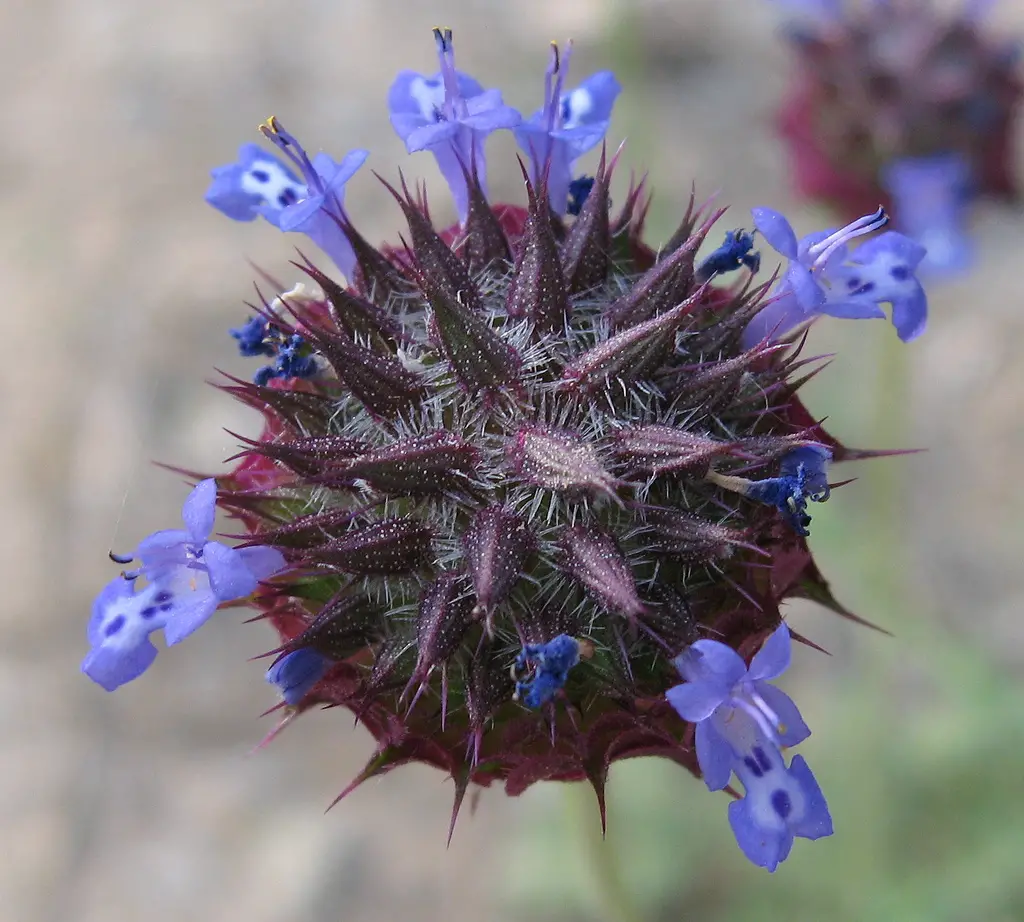
Chia is a distinctive and historically important California wildflower known for its spiky, spherical flower heads and cultural significance. It belongs to the mint family and produces brilliant blue to purple blooms arranged in ball-like clusters along square stems. The plant grows 12 to 18 inches tall and has deeply lobed green leaves that emit a mild scent when crushed. Its seeds were a traditional food source for Native American tribes, prized for their nutrition and energy.
Chia typically blooms from March through May and is found in dry, open habitats such as chaparral, deserts, grasslands, and coastal hillsides. It is especially common in southern and central California, including areas like the Santa Monica Mountains, Anza-Borrego, and the Carrizo Plain. This drought-tolerant plant prefers full sun and sandy or gravelly soils where water drains quickly.
Salvia columbariae plays an important role in local ecosystems, providing nectar for bees, butterflies, and hummingbirds. Its seeds are still harvested today and are known as “chia seeds,” popular for their health benefits. The plant’s beautiful blue blooms and cultural heritage make it a standout among California’s wildflowers, bridging both ecological and human history.
Monkeyflower (Mimulus spp.)

Monkeyflowers are a diverse group of wildflowers that come in a dazzling array of colors, including yellow, orange, red, pink, and purple. Their name comes from the flower’s shape, which some say resembles a monkey’s face. The flowers typically have five rounded lobes and a slightly open mouth, growing on low to medium-sized plants that reach 6 inches to 3 feet tall. Leaves are usually opposite, lance-shaped, and slightly sticky.
These wildflowers bloom from early spring through summer, depending on elevation and species. They are commonly found in riparian areas, seeps, rocky hillsides, and coastal bluffs across California. Some species, like Mimulus guttatus (Seep Monkeyflower), grow in moist areas, while others, like Diplacus aurantiacus (Sticky Monkeyflower), are adapted to drier, scrubby slopes and chaparral environments.
Mimulus species are a favorite of hummingbirds, bees, and butterflies, making them ecologically valuable in native plant gardens and wild habitats. Their colorful, tubular flowers provide excellent nectar sources, while their varied forms allow them to thrive in both wet and dry landscapes. Monkeyflowers add vibrant diversity to California’s wildflower season and are appreciated for both their ornamental beauty and ecological contributions.
Matilija Poppy (Romneya coulteri)
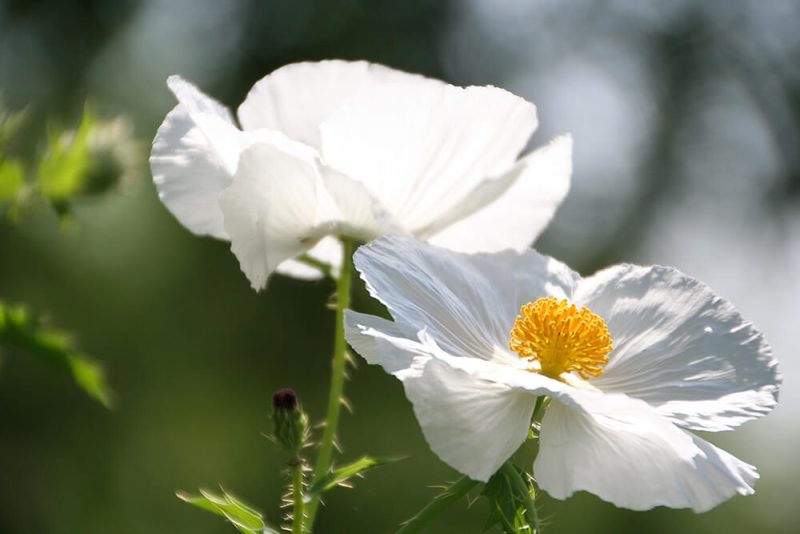
Matilija Poppy is a striking and dramatic wildflower native to California, often referred to as the “fried egg flower” because of its large white petals surrounding a bright yellow center. The flowers can reach up to 6 inches across, making them one of the largest wildflowers in the state. The plant itself is a vigorous shrub-like perennial with woody stems that can grow 6 to 8 feet tall. Its gray-green, deeply lobed leaves provide a textured backdrop to the bold blooms.
This poppy blooms primarily from late spring to early summer, typically between April and July, favoring sunny, well-drained locations such as chaparral, foothills, and open woodlands. It is often found in coastal and inland southern California, including areas like the Santa Monica Mountains and San Gabriel foothills. Matilija Poppy thrives in dry, rocky soils and is well-adapted to California’s Mediterranean climate.
Romneya coulteri is a beloved ornamental in native plant gardens for its impressive flowers and drought tolerance. Its showy blooms attract various pollinators, including bees and butterflies. Though slow to establish, once mature it spreads via underground rhizomes, forming large colonies. The Matilija Poppy’s bold size and delicate beauty make it an iconic and unforgettable part of California’s wildflower heritage.
Blazing Star (Mentzelia lindleyi)
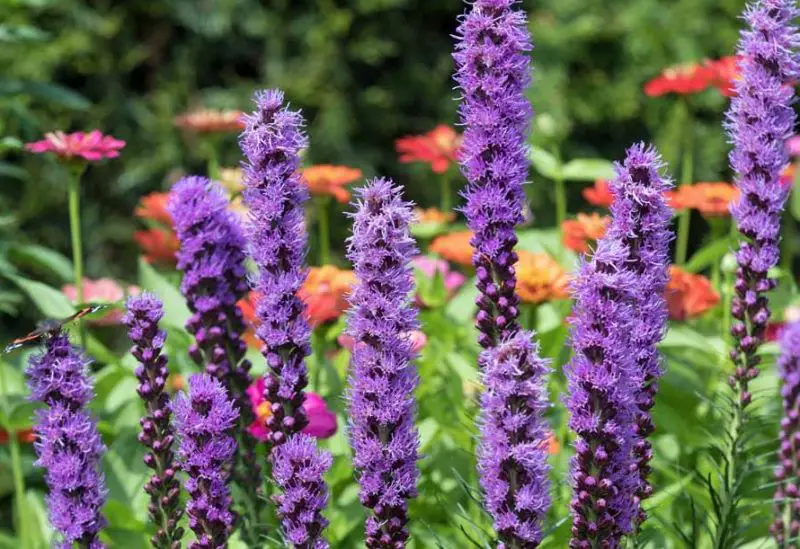
Blazing Star is a vibrant and eye-catching wildflower native to California’s foothills and valleys. Its star-shaped blossoms are bright golden yellow with multiple pointed petals that give the flower a fiery appearance, hence the name “Blazing Star.” The plant grows as a low to medium-sized annual, reaching 6 to 18 inches tall, with narrow, lance-shaped leaves that may have a slightly rough texture.
This wildflower blooms from March through June, thriving in sunny, well-drained soils commonly found in grasslands, chaparral, and open rocky slopes. It is widespread throughout central and southern California, including the Sierra Nevada foothills and the Central Coast region. Blazing Star often appears in profuse numbers, adding a striking yellow glow to springtime hillsides.
Mentzelia lindleyi is important ecologically for its nectar-rich flowers that attract native bees, butterflies, and other pollinators. Its ability to grow in poor, dry soils and resist drought makes it a resilient species in California’s diverse landscapes. The Blazing Star’s intense color and starburst shape make it a favorite among wildflower enthusiasts and photographers alike.
Sticky Monkeyflower (Diplacus aurantiacus)
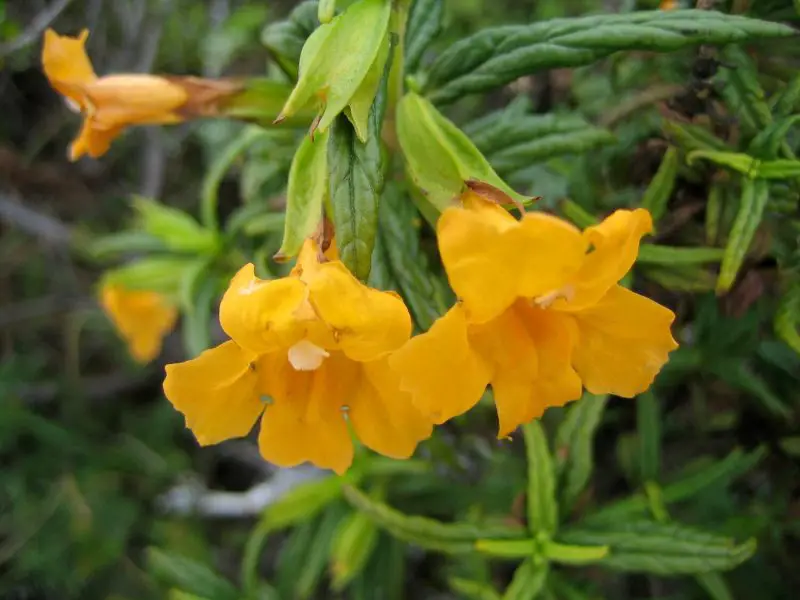
Sticky Monkeyflower is a hardy and colorful shrub native to California’s coastal and chaparral environments. It features tubular flowers in rich shades of orange to deep apricot, often with reddish spots inside the throat. The plant grows as a woody perennial shrub ranging from 1 to 3 feet tall, with sticky, aromatic leaves that help reduce water loss in dry conditions.
Blooming from spring through early fall, Sticky Monkeyflower thrives in sunny, dry habitats such as coastal scrub, chaparral, and foothill woodlands. It is especially common along the California coast from the San Francisco Bay area south to Baja California. The plant prefers well-drained soils and can withstand drought and poor nutrient conditions.
Diplacus aurantiacus is ecologically valuable as it attracts hummingbirds, native bees, and butterflies with its nectar-rich flowers. Its sticky leaves and strong stems provide shelter for various small wildlife. Popular in native plant gardens and restoration projects, Sticky Monkeyflower contributes color and habitat value, representing California’s rugged coastal flora.
Yellow Mariposa Lily (Calochortus luteus)
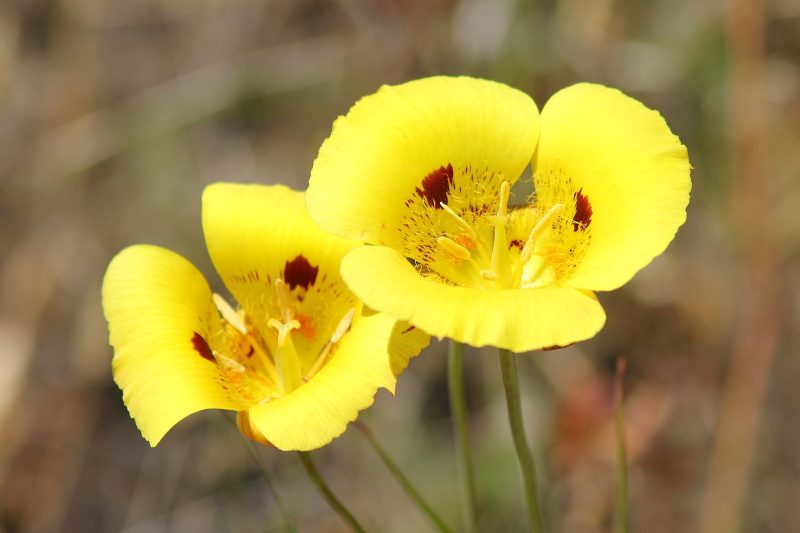
Yellow Mariposa Lily is a beautiful and delicate wildflower native to California’s grasslands and open woodlands. Its cup-shaped blooms are bright yellow with distinctive darker markings or spots near the center, often accompanied by fine hairs on the petals’ inner surfaces. Flowers measure about 2 to 3 inches across and grow atop slender stems reaching 12 to 24 inches tall. The narrow, grass-like leaves grow mostly at the plant’s base.
This species blooms in spring, usually from April to June, favoring well-drained soils in sunny to partly shaded habitats. It is widely distributed across the Central Valley, Sierra Nevada foothills, and coastal ranges. Yellow Mariposa Lily often appears in wildflower mixes with other native bulbs and annuals, adding vibrant color and delicate texture to natural meadows.
Calochortus luteus is an important nectar source for native bees and butterflies. Its unique shape and markings help attract pollinators and protect reproductive parts. Although sensitive to overgrazing and habitat loss, it remains a cherished component of California’s wildflower diversity, celebrated for its elegance and bright color.
Desert Five-Spot (Eremalche rotundifolia)
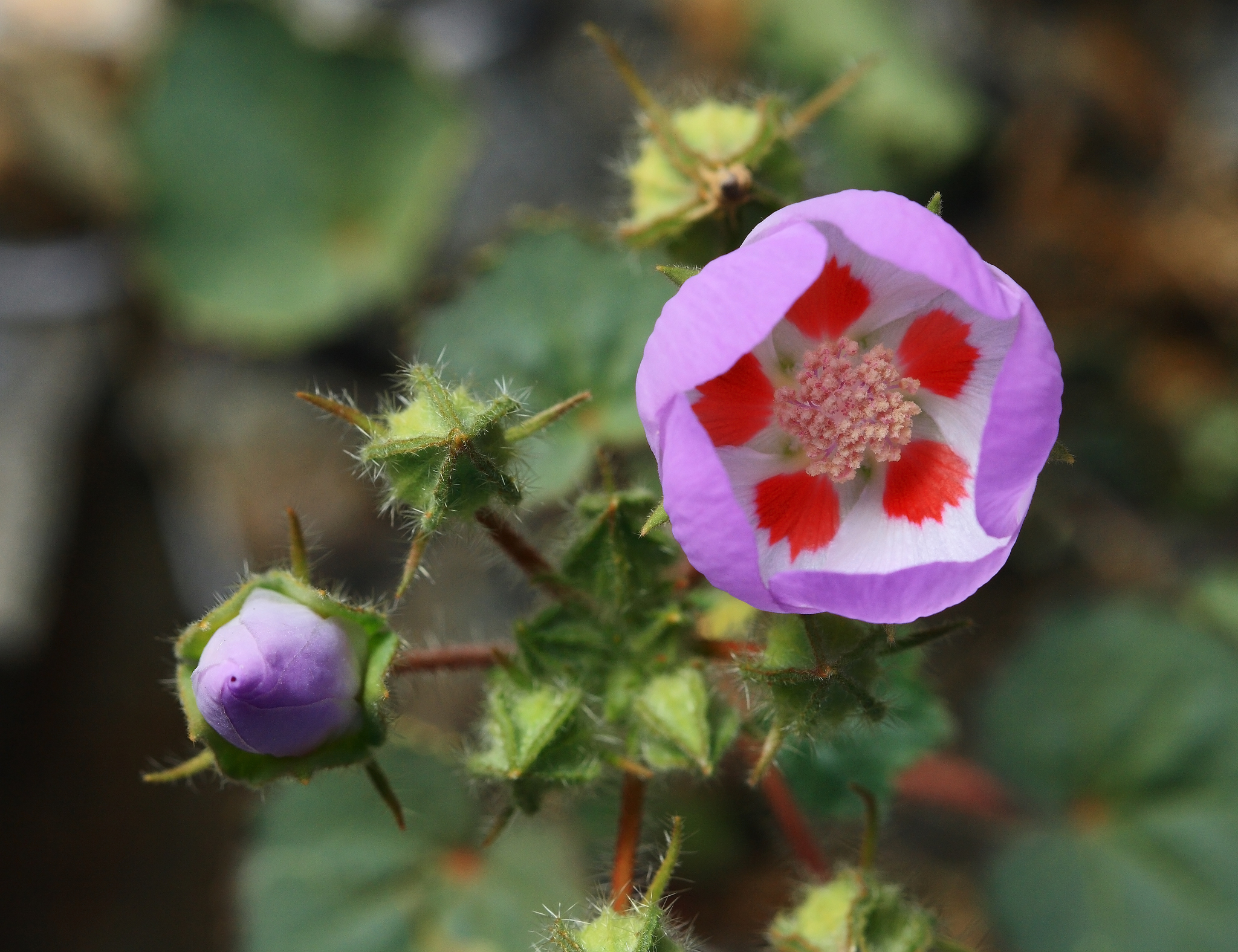
Desert Five-Spot is a rare and striking wildflower native to the sandy deserts of southeastern California. Its pale pink to lavender petals are marked with five deep red spots, one on each petal, giving the flower its distinctive name. Each flower is about 1 to 2 inches wide, growing on slender, branching stems that typically reach 6 to 18 inches tall. The plant has gray-green, fuzzy leaves that help conserve moisture in arid conditions.
This species blooms in spring, usually from March through May, particularly after sufficient winter rainfall. It is primarily found in the Mojave Desert and adjacent desert regions, often growing on sandy flats and washes with well-drained soils. The Desert Five-Spot is known for dramatic “super blooms” that cover the desert floor with its spotted blossoms in favorable years.
Eremalche rotundifolia is adapted to harsh desert environments with extreme heat and dryness. Its deep root system and hairy leaves help reduce water loss, while its bright flowers attract native bees and other pollinators. Though limited in range and vulnerable to habitat disturbance, Desert Five-Spot remains a symbol of the fragile beauty and resilience of California’s desert flora.
FAQ About Wildflowers in California
What Are Wildflowers?
Wildflowers are flowering plants that grow naturally in the wild without intentional planting or cultivation. They are native to a region and adapted to the local climate and soil conditions.
When Is the Best Time to See Wildflowers in California?
The best time to view wildflowers in California is typically from late winter through spring, especially between March and May. The exact timing depends on rainfall and temperature, with wetter winters producing more abundant blooms.
Where Are the Best Places to See Wildflowers in California?
Some of the top locations to see California wildflowers include:
-
Antelope Valley California Poppy Reserve
-
Carrizo Plain National Monument
-
Anza-Borrego Desert State Park
-
Joshua Tree National Park
-
Sierra Nevada foothills
-
Coastal grasslands and meadows
What Are Some Common Wildflower Species in California?
Popular wildflowers in California include California Poppy, Lupine, Tidy Tips, Baby Blue Eyes, Indian Paintbrush, Desert Marigold, and Matilija Poppy, among many others.
How Do Wildflowers Benefit the Ecosystem?
Wildflowers provide important habitat and food sources for native pollinators like bees, butterflies, and hummingbirds. They help improve soil health, prevent erosion, and maintain biodiversity.
Can I Grow California Wildflowers in My Garden?
Yes, many California wildflowers are suitable for native and drought-tolerant gardens. They generally prefer well-drained soil and full sun. It’s best to source seeds or plants from native plant nurseries and avoid invasive species.
Are California Wildflowers Protected?
Some wildflower species and their habitats are protected by state or federal laws, especially in designated reserves and parks. It is important to enjoy wildflowers responsibly and avoid picking or damaging them in the wild.
What Causes “Super Blooms” in California?
Super blooms occur when a wet winter is followed by mild spring weather, leading to an explosion of wildflower growth and vibrant, widespread blooming across the landscape.
How Can I Help Preserve Wildflower Habitats?
You can help by supporting conservation efforts, avoiding trampling wildflower areas, planting native species in your garden, and educating others about the importance of wildflowers to California’s ecosystems.


